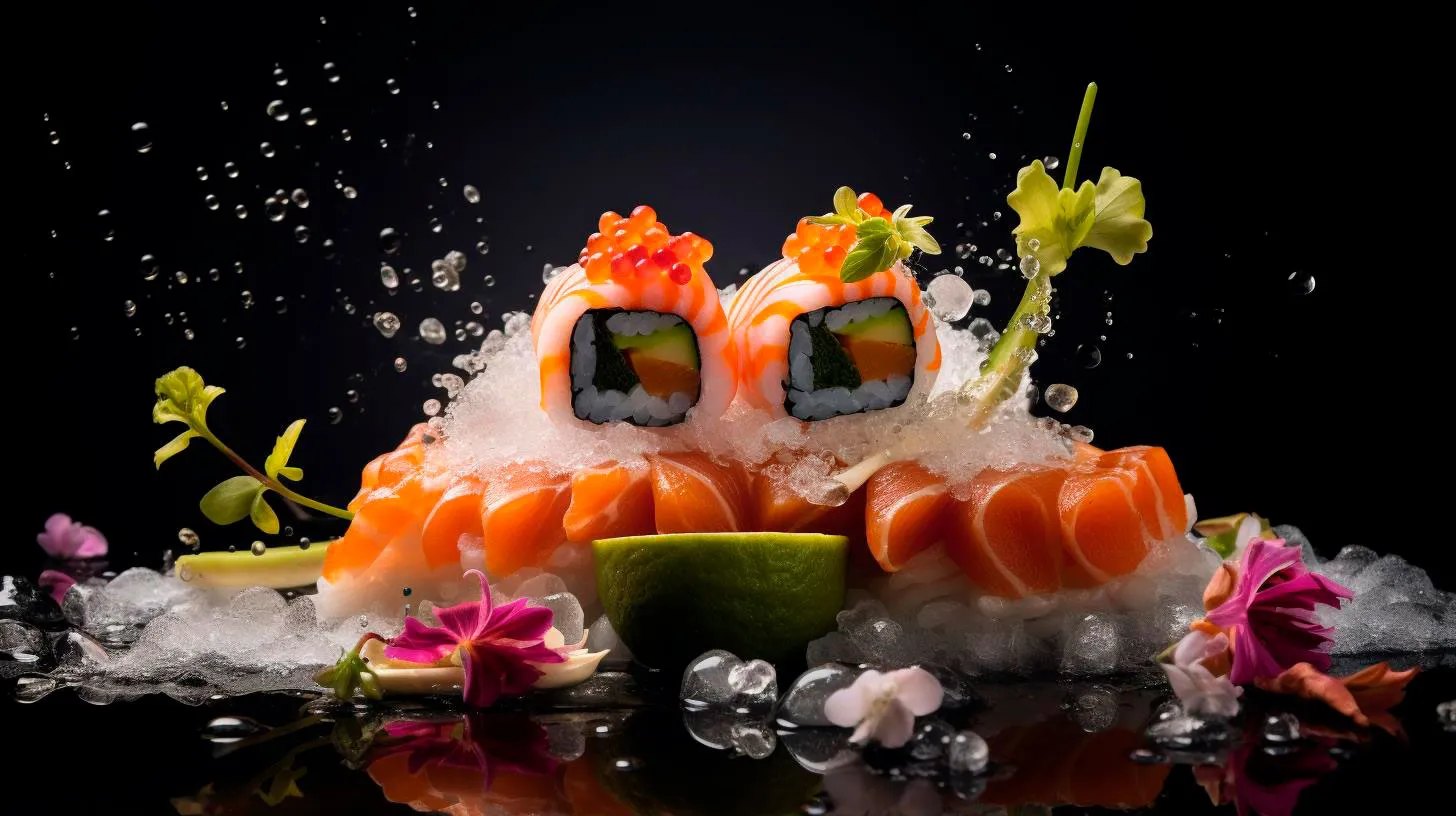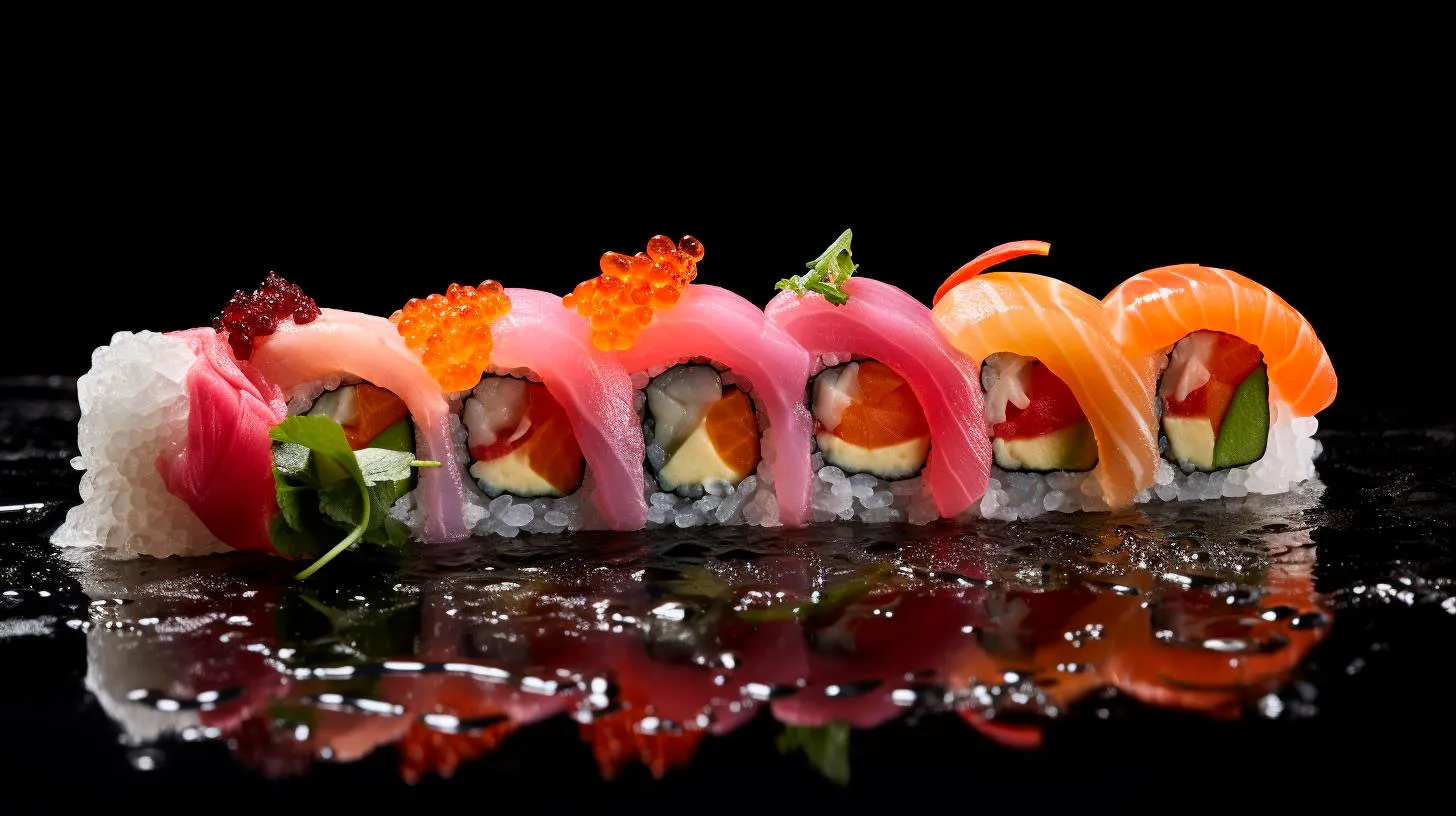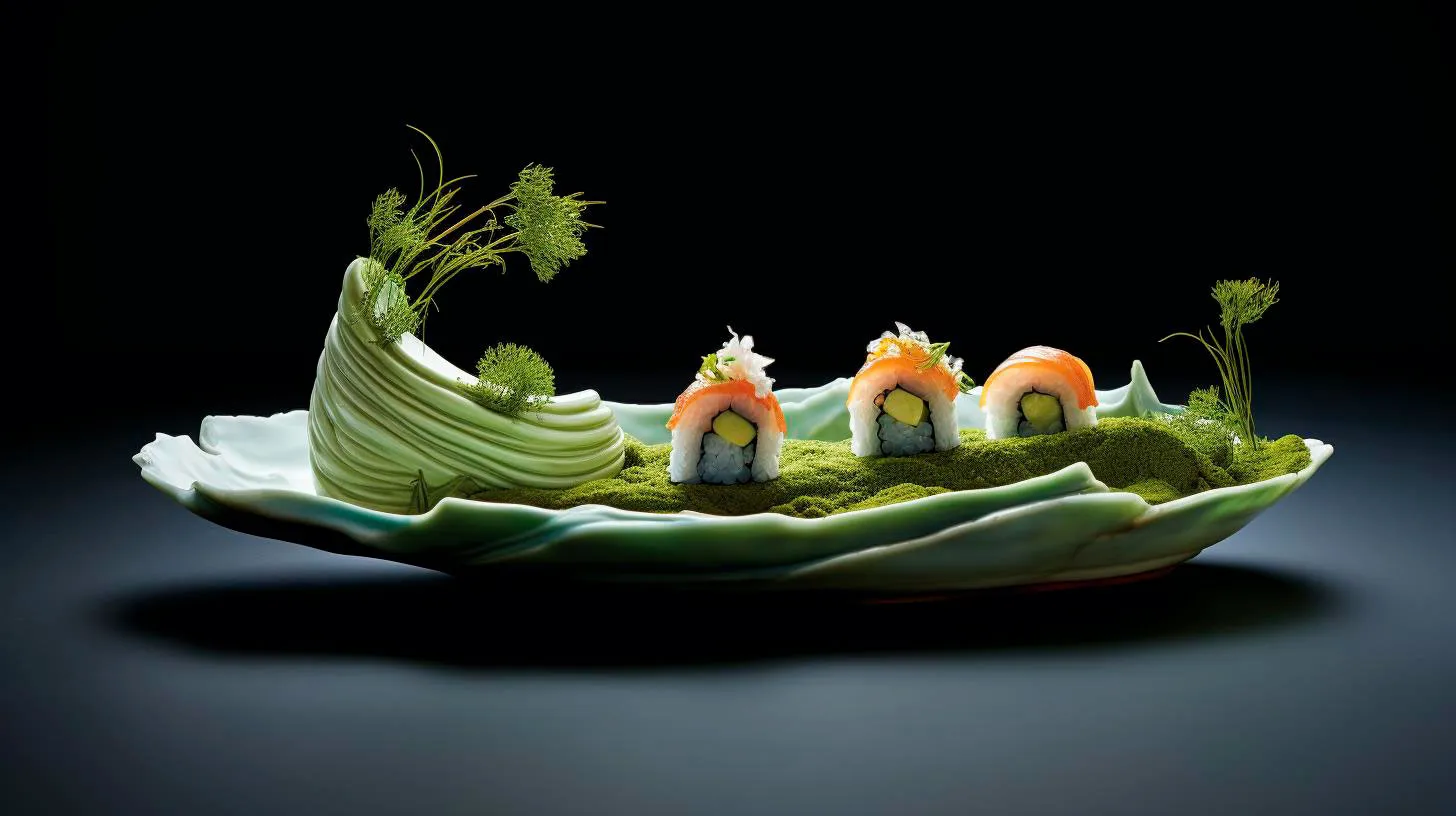Exploring the Delicate Balance of Tradition and Innovation in Sushi Preparation
The Importance of Tradition
Traditional sushi, known as Edo-style sushi, originated during the Edo period in Japan. It was initially a street food available at food stalls and later transformed into a fine dining experience. Here are a few key elements that define traditional sushi:
- Fresh and high-quality ingredients: Traditional sushi emphasizes the use of fresh, seasonal fish and locally sourced ingredients.
- Handcrafted techniques: Sushi chefs meticulously prepare each piece by hand, ensuring the perfect balance of flavors, textures, and visual appeal.
- Simplicity: Traditional sushi highlights the natural flavors of the fish, often served with minimal accompaniments like wasabi, soy sauce, or pickled ginger.
- Omakase: The concept of omakase, meaning “chef’s choice,” allows the chef to showcase their culinary skills by serving the best seasonal ingredients in a carefully curated sequence.
Traditional sushi is deeply rooted in Japanese culture and reflects the craftsmanship and attention to detail that define this art form. It’s a testament to the timeless appeal of sushi that traditional techniques and flavors continue to thrive in modern sushi restaurants around the world.
The Art of Sushi Innovation
While tradition forms the foundation of sushi, chefs today embrace innovation to push the boundaries of what sushi can be. This fusion of tradition and innovation allows for exciting new flavors and experiences. Here are some examples of sushi innovation:
- Non-traditional ingredients: Chefs experiment with unconventional ingredients to create unique flavor combinations and textures.
- Fusion sushi: The fusion of different culinary traditions introduces new elements into sushi, such as incorporating Latin American or European flavors.
- Modern presentation: Sushi chefs incorporate artistic elements and modern plating techniques to enhance the visual appeal of their creations.
- Alternative preparation techniques: While hand-rolling sushi is the traditional method, innovative techniques like flash-freezing or sous vide have gained popularity among modern sushi chefs.
By blending traditional techniques with contemporary influences, sushi chefs continue to surprise and delight diners with innovative and bold creations while maintaining the core essence of sushi culture.
The Benefits of Embracing Both Tradition and Innovation
The delicate balance between tradition and innovation in sushi preparation brings numerous benefits and enriches the culinary landscape. Here are some key advantages:
- Cultural preservation: Honoring tradition ensures that the art of sushi making is passed down through generations, preserving its cultural significance.
- Creative expression: Innovation allows sushi chefs to express their creativity, resulting in unconventional yet delicious creations.
- Expanded options: Incorporating innovation widens the range of flavors and ingredient choices, catering to diverse palates and dietary preferences.
- Enhanced dining experiences: By combining tradition and innovation, sushi restaurants provide customers with a unique and memorable dining experience.
In the evolving culinary world, finding the balance between tradition and innovation is crucial to keeping a cuisine alive while embracing new culinary concepts and flavors. Sushi is a perfect example of how innovation can complement tradition, resulting in a harmonious blend that captivates food enthusiasts worldwide.
Key Takeaways
1. Tradition: Traditional sushi focuses on fresh ingredients, handcrafted techniques, simplicity, and the chef’s expertise in the omakase experience.
2. Innovation: Sushi chefs experiment with non-traditional ingredients, fusion flavors, modern presentation, and alternative preparation techniques.
3. Benefits: Balancing tradition and innovation preserves culture, allows for creative expression, offers expanded options, and enhances dining experiences.
Exploring the delicate balance of tradition and innovation in sushi preparation showcases the enduring allure and adaptability of this ancient cuisine. By embracing both aspects, sushi chefs continue to delight and surprise diners with their artistry and passion.
Mastering the Art of Sushi Etiquette and Cultural Significance
Dive deeper into the art of sushi etiquette and immerse yourself in the cultural significance of this culinary tradition.
The Importance of Sushi Etiquette
Sushi etiquette plays a vital role in Japanese society and reflects the values and traditions deeply rooted in their culture. By adhering to these customs, you can enhance your dining experience, show respect to the chef, and fully embrace the essence of sushi.
Key Sushi Etiquette Practices to Master
- Using Chopsticks: Unless otherwise specified, it is customary to eat sushi with chopsticks. Practice using chopsticks to pick up the sushi pieces gently and avoid excessive force that may damage the delicate structure.
- Soy Sauce Dipping: When dipping your sushi into soy sauce, do it with the fish-side down to ensure the flavors are preserved and the rice does not absorb an excessive amount of soy sauce.
- Wasabi Integration: Mix a small amount of wasabi into the soy sauce dish. Avoid putting wasabi directly onto the sushi, as the chef has already balanced the flavors for you.
- Ordering and Eating: Sushi is typically served in courses, starting with lighter flavors and progressing to bolder options. It is considered polite to order a variety of sushi and try everything that is presented to you.
- Ginger Garnish: The ginger provided is intended to cleanse the palate between different sushi pieces. Take a small piece of ginger, lightly dip it in soy sauce, and enjoy it between bites. Avoid putting ginger directly on top of the sushi.
The Cultural Significance of Sushi
Sushi not only represents Japan’s culinary excellence but also carries significant cultural meaning. Understanding the cultural significance of sushi can deepen your appreciation for this ancient art form.
Sushi as an Art and Craftsmanship
Preparing sushi is regarded as a true art form. It demands years of practice and expertise to perfect the skills required to create visually stunning and appetizing sushi rolls. Sushi chefs, known as Itamae, dedicate their lives to honing their craft and creating edible masterpieces.
Sushi as a Symbol of Unity
In Japan, sushi is often enjoyed as a communal experience, bringing people together. Sharing a plate of sushi reinforces the cultural value of harmony and togetherness. It symbolizes unity and fosters social connections.
Celebrating Seasonal Ingredients
Sushi demonstrates a deep respect for nature and the changing seasons. Traditional sushi-making techniques prioritize the use of local, seasonal ingredients. By doing so, sushi chefs ensure the freshness and quality of each sushi piece, celebrating the bounties of nature.
Benefits of Adhering to Sushi Etiquette
Mastering sushi etiquette not only shows respect for Japanese culture but also enhances your dining experience. Adhering to these customs can lead to a harmonious and enjoyable sushi experience.
Enhanced Tastes and Textures
By following sushi etiquette, you can savor each sushi piece as intended by the chef. The balance of flavors and textures becomes more apparent, allowing you to appreciate the intricacies of each ingredient.
Cultural Immersion and Appreciation
Understanding and embracing sushi etiquette enables you to immerse yourself in Japanese culture. It showcases your appreciation for their customs and traditions, allowing for a more authentic and enjoyable dining experience.
Respect for the Chef and Culinary Artistry
Respecting the sushi chef’s expertise and adhering to the established practices of sushi etiquette acknowledges their culinary artistry. It fosters a positive relationship between the chef and the diner, and the chef will likely take notice of your appreciation.
Mastering the art of sushi etiquette is an ongoing journey that adds depth to your sushi experience. By embracing the customs, you can enjoy sushi not only as a delicious culinary delight but also as a gateway to Japanese culture and tradition.
Understanding the Intricate Culinary Tradition of Sushi and Nori
One of the essential elements of sushi is nori, a type of edible seaweed that adds a unique flavor and texture to this culinary delight.
The Importance of Nori in Sushi
Nori plays a vital role in sushi, both in terms of taste and aesthetics. This edible seaweed is primarily harvested from the coastlines of Japan and other East Asian countries. It is processed into thin, dark green sheets that are used as wrappers for the sushi ingredients. Nori imparts a distinct umami flavor to the sushi, enhancing its overall taste profile. Additionally, the texture of nori provides a delicate crunch, adding depth and complexity to every bite.
The Types of Nori
Nori comes in various types, each offering its unique characteristics. The two most common types are:
- Asakusa-Nori: This type of nori is best suited for sushi rolls and onigiri. It has a smooth, glossy texture and a slightly sweet taste.
- Hoshi-Nori: Hoshi-Nori is dried nori that is often used for making sushi toppings. It has a crispier texture and is ideal for garnishing.
These different types of nori allow chefs and sushi enthusiasts to explore a range of flavors and textures, making each sushi creation a unique experience.
Nurturing a Culinary Tradition
Sushi-making is not just about preparing a meal; it is an art form that has been passed down through generations. The meticulousness involved in creating the perfect sushi requires patience, skill, and knowledge about the ingredients and techniques. Understanding the culinary tradition of sushi and nori can help deepen appreciation for the craft.
Key Takeaways:
- Sushi is a traditional Japanese cuisine that has gained global popularity.
- Nori is an essential component of sushi, providing taste, texture, and visual appeal.
- There are different types of nori with unique characteristics.
- Sushi-making is an art form that requires skill and knowledge.
Health Benefits of Nori
Besides its culinary importance, nori brings several health benefits to the table. This nutrient-rich seaweed is packed with essential vitamins, minerals, and other compounds that promote overall well-being. Here are some of the health benefits associated with nori:
- Rich in Minerals: Nori contains significant amounts of minerals like iodine, calcium, iron, and potassium, which are necessary for maintaining proper bodily functions.
- Antioxidant Powerhouse: It is rich in antioxidants such as vitamin C and carotenoids, which help fight against harmful free radicals and reduce the risk of chronic diseases.
- Improved Thyroid Health: The iodine content in nori supports a healthy thyroid, which plays a crucial role in regulating metabolism.
- Heart-Healthy: Nori contains heart-friendly omega-3 fatty acids that help reduce the risk of cardiovascular diseases.
Key Takeaways:
- Nori offers various health benefits due to its nutrient content.
- It is a rich source of minerals and antioxidants.
- Nori supports thyroid health and promotes a healthy heart.
Embracing Sushi Culture
Sushi is not just a meal; it is a representation of Japanese culture and tradition. Understanding the significance of sushi and nori can help us appreciate the craftsmanship and dedication that goes into each piece of sushi. By embracing sushi culture, we gain a deeper understanding of its complexities and enhance our culinary experiences.
Key Takeaways:
- Sushi represents Japanese culture and tradition.
- Appreciating sushi enhances our culinary experiences.
As we unravel the intricate culinary tradition of sushi and nori, we discover the artistry, unique flavors, and health benefits that make this cuisine a global sensation. So, next time you savor a sushi roll, take a moment to appreciate the rich cultural heritage and the culinary expertise that goes into creating this extraordinary dish.
Nori: A Guide to Japanese Seaweed and Sushi Etiquette
Whether you are a sushi enthusiast or simply curious about Japanese cuisine, this guide will provide you with valuable insights.
The Origins of Nori
Nori, also known as Porphyra, is a type of red seaweed that has been an integral part of Japanese cuisine for centuries. It is believed that nori was first cultivated in Japan during the Nara period (710-794 AD). Back then, people would harvest wild nori from the coastlines to use in various dishes. However, it was during the Edo period (1603-1868 AD) that nori farming techniques were developed, leading to its widespread availability and consumption. Today, nori is not only enjoyed in Japan but has become popular worldwide.
Nutritional Value of Nori
Nori offers an impressive array of health benefits. Rich in essential vitamins and minerals, it is a nutritious ingredient to include in your diet. Here are some key nutritional facts about nori:
- High in iodine, which is essential for thyroid function
- Rich in vitamins A, B, and C
- Contains iron, calcium, and magnesium
- Low in calories and fat
- High in fiber
- Contains antioxidants that help fight free radicals
- Offers protein and amino acids
Incorporating nori into your meals can contribute to a balanced and healthy diet, supporting your overall well-being.
Nori in Sushi Etiquette
In Japan, sushi is not just a meal but an art form that reflects the country’s culture and traditions. When it comes to sushi etiquette, there are certain customs to follow to fully appreciate the experience. Here are some key points to remember:
1. Handling Nori
When eating sushi rolls, it is essential to handle the nori with care. Use your fingers to hold the sushi, ensuring the shiny side of the nori faces outward. This allows you to fully enjoy the delicate flavors and textures of the roll.
2. Eating Sushi Rolls
When eating sushi rolls wrapped in nori, take small, bite-sized portions. This ensures that each bite incorporates a balanced mix of flavors and prevents the roll from falling apart. Avoid separating the nori from the roll; instead, enjoy it as a cohesive unit.
3. Respectful Consumption
While sushi rolls can be enjoyed at any pace, it is customary to consume them promptly after they are served. Nori can become soggy if left untouched for too long, compromising the overall taste and texture of the roll.
4. Appreciating Umami
Nori contributes to the umami flavor, a savory taste sensation often associated with Japanese cuisine. Take a moment to savor the combined taste of the nori, rice, and fillings, appreciating the artistry behind the sushi roll.
Key Takeaways
- Nori, a type of red seaweed, is a crucial ingredient in sushi.
- It has a rich culinary history originating from Japan.
- Nori boasts numerous health benefits and is packed with essential nutrients.
- When enjoying sushi, follow proper etiquette when handling and eating nori-wrapped rolls.
- Appreciate the umami flavor that nori adds to sushi rolls.
Now armed with knowledge about nori and sushi etiquette, you can confidently embark on your next sushi adventure. Whether you choose to dine at a sushi restaurant or try your hand at making sushi at home, understanding the importance of nori will enhance your overall experience. So go ahead, indulge in the wonderful world of sushi and enjoy the unique flavors that nori brings to the table.


